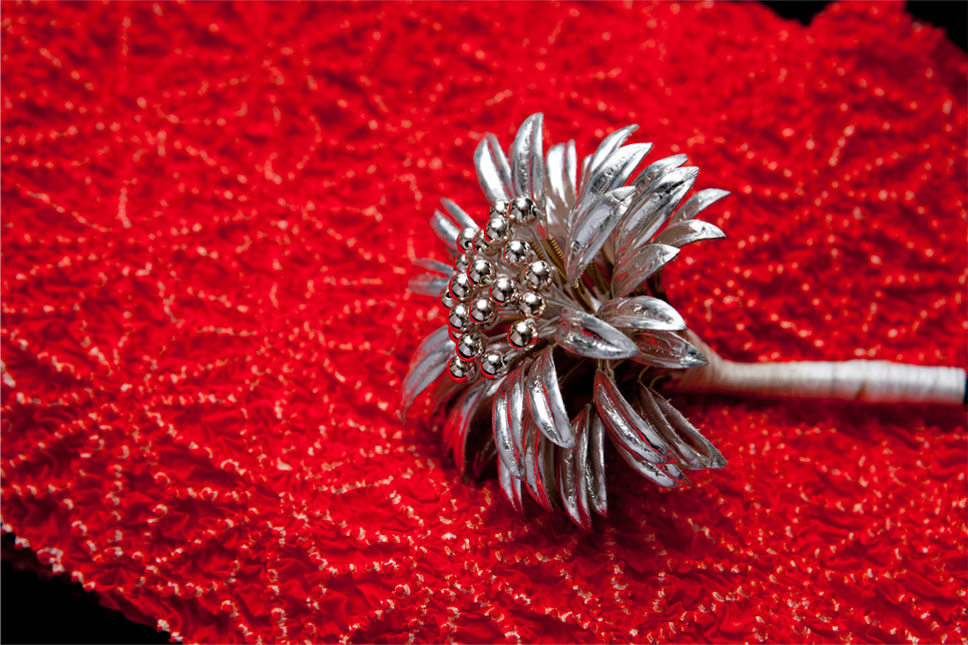Concept
理念


浅葱色の鹿の子とかんざし
(所蔵:光峯床山、撮影:トニータニウチ)
道具のチカラで、伝統芸能を輝かせる
能楽や歌舞伎は、ユネスコの世界無形文化遺産にも登録された高水準の伝統芸能であり、グローバル化した国際社会においては日本を象徴する役割も担う貴重な存在である。芸術性の高い繊細な舞台表現は、俳優の演技によるところが大きいが、大道具、衣裳、小道具など多種多様な道具類がそれを下支えしている。これらの道具類は、手間のかかる高度な伝統技術で作られおり非常に質が高いが、それゆえ経済性が悪く、技術習得が困難なため後継者問題にも悩まされている。こうした道具類の技術の低下が積み重なれば総合芸術としての質は著しく損なわれることになる。
これまで大切に継承されてきた能楽、歌舞伎、文楽などの“舞台で上演される伝統芸能”、地域とつながりながら“土地で演じられる郷土芸能”。それらの質を保ちながら未来へ継承するために、衰退した道具を復元させる「調査・分析・復元」のスキームを確立し、技術継承の新しいモデルを生み出す。また、伝統芸能の道具の作り手が安定して仕事ができるためのよりよい環境づくりにも取り組む。さらに、伝統芸能の道具の世界と、一般社会のそれぞれでネットワークを広げ、両者をつなぐ橋渡しをするプラットフォームとしての役割も担っていきたい。
Maintaining quality and cultural value of Japanese traditional theatrical stage tools
Two core traditional Japanese performing arts, Nohgaku and Kabuki are listed as World Cultural Heritages. Although much of the delicacy and impact of these performances depends on the skill of the actors, a large part is also based on the various traditional and finely made props, costumes, musical instruments and so on, which we will group under the term “stage tools”. The long history of Japanese theatre has produced highly skilled artists and technicians, capable of creating extremely high quality stage tools. However, these skills are now being lost as young Japanese turn to more modern careers, partly because these crafts pay relatively poorly compared to other jobs and partly simply as young people tend to follow more modern trends. The risk is that, with the loss of these traditional craft skills, the quality of the stage tools used in traditional performances will be hugely reduced. To maintain the high quality of Nohgaku and Kabuki, some way must be found to encourage potential new craftsmen and women to become interested in these traditional arts. The cultural value of these skills should be far higher than they are at present, and we need to ensure that the artists can make a better living than is presently the case. We wish to link the world of high stage tool craftsmanship to that of the general public, by an information campaign.

道具ラボ目標
<目標>
日本の伝統芸能に用いる道具類の希少技術を未来へ継承する。
<目的>
日本の伝統芸能に用いる道具類の技術を保存し活用するためのネットワーク・プラットフォームを構築する。
衰退した道具を復元させる「調査・分析・復元」のスキームを確立し、技術継承の新しいモデルを生み出す。
伝統芸能の道具類の製作に関わる後継者問題を解決する。
日本の伝統芸能の奥深い魅力を道具類の技術を通して国内外に広く伝える。
伝統芸能の道具の質が低下するのを防ぐため、「道具の質を見極める眼をもつ観客(道具の見巧者)」を増やす。
<具体的な活動>
【伝統芸能の製作現場での調査と分析】
伝統芸能の道具を作る製作現場についての調査とそれに基づいた分析。
- 1.製作現場の調査とその資料分析:道具類の技術継承の実体を「見える化」するための調査を行う。
- 2.資料化:調査内容を、だれにでもわかるような「資料」として文書化する。
【一般社会へ向けてのアクション】
日用品としての伝統工芸の製作現場や一般社会などへ向けて起こす行動。
<Goal>
Maintain the high quality of the skills and crafts necessary for creating the stage tools used in the Japanese traditional performing arts.
<Objectives>
Establish a network to preserve the skills and crafts of stage tool-making, using traditional materials, in the Japanese traditional theatre world;
Create a new model of apprenticeship in the skills necessary for the creation of traditional stage tools through investigation and analysis;
A national and international information campaign on the cultural need to maintain the quality of Japanese traditional theatre through ensuring that the skills needed for stage tool-making are passed on through the generations.
<Activities>
[Investigation and analysis in the world of traditional stage tool craftsmanship]
This activity is focused on the workshops where the stage tools are produced by traditional craftsmen and women.
- 1. Observe stage tool production at the workshops and investigate how the skills in transforming the materials into beautiful art objects are acquired and passed on;
- 2. Report on the observations and conclusions in a way that is easily understood by the general public.
[Action aimed at the public]
This activity is focused on traditional art production and the general public.
- 3. Restoration of stage tool-making techniques where stage tool-making techniques have been lost, and examination on how these can be restored;
- 4. Transparency of investigation methods: all interviewees and stakeholders will be kept informed, in writing, of all meth ods, expected results, and documented conclusions;
- 5. Wide distribution of information: a website allows the investigation process and the results to be available to the public;
- 6. Skilled crafts and techniques are passed on:
Encourage young people, both nationally and internationally, to become professional stage tool-making craftsmen and women through lectures, workshops, and recruiting announcements.


ロゴマークについて
黒い四角は、伝統芸能の「舞台」を表しています。その舞台の上にあるマークは「道具の象徴」です。伝統芸能の道具はさまざまな種類がありますが、「伝統芸能の道具ラボ」で初めて復元させた歌舞伎の髪飾り「鹿の子」(このページのトップにある赤い布)を代表させて、その模様である「麻の葉模様」をモチーフとしました。
4つの麻の葉は、
- 伝統芸能の舞台で演じる「俳優」
- 伝統芸能の舞台を道具や技術で支える「裏方・職人」
- 伝統芸能を楽しむ観客、日本文化に関心をもつ「世界中の人々」
- 「伝統芸能の道具ラボ」
を表しています。この4者をうまく連携させて、伝統芸能の舞台を輝かせたいと思っています。麻の葉は成長が早い植物で、昔は子どもの成長を願って子どもの着物などに「麻の葉模様」がよく使われていました。ロゴのなかの「麻の葉模様」には、伝統芸能、そして「伝統芸能の道具ラボ」が発展することを願う意味も込めています。
デザイン:村上千博(Birds http://www.birdsdesign.com/)
制作年 :2012年
ご協力のお願い
【一般市民の方に協力していただきたいこと】
・伝統芸能の道具に関心を持ち、客席からその技術のよしあしを見極める眼を持っていただきたいと思っています。
「道具のファン」「道具の見巧者」が増えれば、道具の質の低下をくいとめることができます。
【企業、行政などにご協力していただきたいこと】
・継続的にこの活動を続けていくために、研究コンテンツを軸にした収益事業の立ち上げを模索しています。
- →CSRや社内研修(文化研修)など協働できそうな機会がありましたら、ぜひお声掛けください。
- →商品を販売されている企業の方へ:売上げの一部を寄付する「寄付つき商品」のご検討をお願いします。
「道具ラボについて」をさらに見る:




